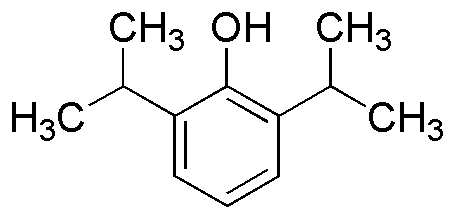2,6-Diisopropylphenol is widely utilized in research focused on:
- Antioxidant Applications: This compound serves as an effective antioxidant in various formulations, helping to prevent oxidative damage in products such as cosmetics and food preservatives.
- Industrial Lubricants: It is used in the formulation of high-performance lubricants, enhancing the stability and performance of oils under extreme conditions, making it valuable in automotive and machinery industries.
- Pharmaceutical Intermediates: The compound acts as an intermediate in the synthesis of pharmaceuticals, contributing to the development of drugs with improved efficacy and reduced side effects.
- Polymer Additives: It is incorporated into polymers to improve thermal stability and resistance to degradation, which is crucial in the production of durable plastics and coatings.
- Research in Chemical Synthesis: Researchers utilize this compound in various chemical reactions, exploring its unique properties to develop new materials and compounds with specific functionalities.
General Information
Properties
Safety and Regulations
Applications
2,6-Diisopropylphenol is widely utilized in research focused on:
- Antioxidant Applications: This compound serves as an effective antioxidant in various formulations, helping to prevent oxidative damage in products such as cosmetics and food preservatives.
- Industrial Lubricants: It is used in the formulation of high-performance lubricants, enhancing the stability and performance of oils under extreme conditions, making it valuable in automotive and machinery industries.
- Pharmaceutical Intermediates: The compound acts as an intermediate in the synthesis of pharmaceuticals, contributing to the development of drugs with improved efficacy and reduced side effects.
- Polymer Additives: It is incorporated into polymers to improve thermal stability and resistance to degradation, which is crucial in the production of durable plastics and coatings.
- Research in Chemical Synthesis: Researchers utilize this compound in various chemical reactions, exploring its unique properties to develop new materials and compounds with specific functionalities.
Documents
Safety Data Sheets (SDS)
The SDS provides comprehensive safety information on handling, storage, and disposal of the product.
Product Specification (PS)
The PS provides a comprehensive breakdown of the product’s properties, including chemical composition, physical state, purity, and storage requirements. It also details acceptable quality ranges and the product's intended applications.
Certificates of Analysis (COA)
Search for Certificates of Analysis (COA) by entering the products Lot Number. Lot and Batch Numbers can be found on a product’s label following the words ‘Lot’ or ‘Batch’.
*Catalog Number
*Lot Number
Certificates Of Origin (COO)
This COO confirms the country where the product was manufactured, and also details the materials and components used in it and whether it is derived from natural, synthetic, or other specific sources. This certificate may be required for customs, trade, and regulatory compliance.
*Catalog Number
*Lot Number
Safety Data Sheets (SDS)
The SDS provides comprehensive safety information on handling, storage, and disposal of the product.
DownloadProduct Specification (PS)
The PS provides a comprehensive breakdown of the product’s properties, including chemical composition, physical state, purity, and storage requirements. It also details acceptable quality ranges and the product's intended applications.
DownloadCertificates of Analysis (COA)
Search for Certificates of Analysis (COA) by entering the products Lot Number. Lot and Batch Numbers can be found on a product’s label following the words ‘Lot’ or ‘Batch’.
*Catalog Number
*Lot Number
Certificates Of Origin (COO)
This COO confirms the country where the product was manufactured, and also details the materials and components used in it and whether it is derived from natural, synthetic, or other specific sources. This certificate may be required for customs, trade, and regulatory compliance.


